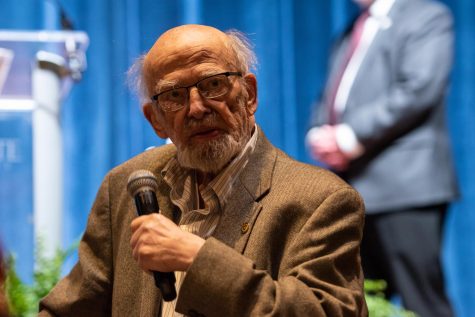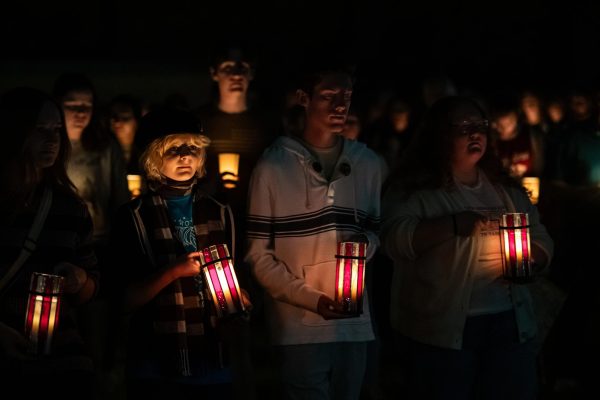The long road to a bachelor’s degree
October 28, 2010
Very few students take the Debbie Grandberry route to school.
Grandberry, a senior electronic media production major who plans to get into film directing, catches the PARTA bus from Cleveland to Kent every morning.
Monday through Thursday, she gets on the bus at 7:50 a.m. at West Prospect Avenue and departs at 4 p.m. from the Student Center.
 “I’ve literally been running behind the bus like, ‘Wait! Wait! Stop! Stop!’” she said, laughing about how she’d have to sleep in the library if she ever missed the bus home.
“I’ve literally been running behind the bus like, ‘Wait! Wait! Stop! Stop!’” she said, laughing about how she’d have to sleep in the library if she ever missed the bus home.
Overall, she said her experience as a Kent State student outweighs the inconvenience of commuting.
She said her teachers have been “patient and supportive” of her situation. The earliest she can arrive in Kent is 9:20 a.m., so each semester, she explains to professors of early morning and evening classes how limited transportation forces her to arrive late and leave early.
“I don’t want them to think I’m absent and don’t really care about coming,” she said. “If they say ‘Well, we don’t want you to miss that much of class,’ then I need to register for something else.”
A hindering factor for potential students, other than early pick-up time and long commute, includes the cost of riding the bus. Each ride from Cleveland to Kent State costs $5, meaning Grandberry spends more than $600 for round-trip bus fare per semester. She finds living in Cleveland to be less expensive than Kent, though.
The cost deterrent alone might be reason for many place-bound students to end their schooling after earning an associate’s degree. Grandberry, however, who transferred 68 credit hours over from Cuyahoga Community College, plans to earn her bachelor’s degree in August.
According to Plain Dealer article published Sept. 17, there have been talks about a possible collaboration with Kent State offering undergraduate courses at Tri-C.
Other colleges and universities have already enacted similar partnerships for select majors. Terra Community College merged with seven Ohio universities through a dual enrollment option, on-site bachelor’s degrees and online bachelor’s degrees.
Eleven community colleges and technical colleges offer online bachelor’s degrees through Ohio University.
Dan Evans, executive dean for regional campuses and vice provost of Ohio University, said the school experienced a significant increase in enrollment since the program’s implementation two years ago. He said 27 students registered in 2008, about 250 registered in 2009 and more than 1,000 enrolled in 2010.
Greg Blase, associate director of Kent State’s School of Journalism and Mass Communication, said he was unsure of the details about a Kent State and Tri-C collaboration. He said it’s a lot to ask a Kent State professor who already teaches courses at Kent to drive to Tri-C to teach courses. If professors taught undergraduate courses at Tri-C, he added that Kent State would have to receive some or all of the revenue.
“In the School of Journalism and Mass Communication, I know we would never put our stamp on somebody saying that you have an electronic media production degree or news degree unless we teach them the bulk of those major courses,” Blase said.
Lastly, he said a large amount of resources must be added in order to teach two more years of course work at Tri-C.
Grandberry said she encourages other place-bound students to stay persistent and not think of commuting to Kent as a dilemma. She said a higher education will pay off in the long run, but admitted that obtaining a four-year degree closer to home sounded appealing.
“If I, or the future Debbie Grandberrys, can go to Tri-C and get the same education, that’s definitely a plus,” she said. “I wish they offered it now.”
Blase said he understands why the state is pushing partnerships between community colleges and universities though. Part of the reason, he said, is the brain drain, which is when students leave the state after receiving an education.
By offering place-bound students four-year degrees at a community college, he said there’s a better chance they’ll stay in the state and contribute to the local economy.
“We’ve had trouble,” Blase said, “getting students who do all these courses at Tri-C, take the core classes and then take some of the JMC classes, to come down here because it’s too far.”
In the meantime, that long-distance commute remains the only route for place-bound students like Debbie Grandberry.
var so = new SWFObject(‘http://www.staterinteractive.com/player.swf’,’mpl’,’376′,’282′,’9′);
so.addParam(‘allowscriptaccess’,’always’);
so.addParam(‘allowfullscreen’,’true’);
so.addParam(‘flashvars’,’&file=commuter_video.flv&image=http://www.staterinteractive.com/doublelayer.jpg&frontcolor=6666FF&lightcolor=EEEEEE&skin=http://www.staterinteractive.com/snel.swf&streamer=rtmp://flashmedia.kent.edu/fms-jmc/knn/’);
so.write(‘commuter_video’);
You can contact Joey Pompignano at [email protected].























